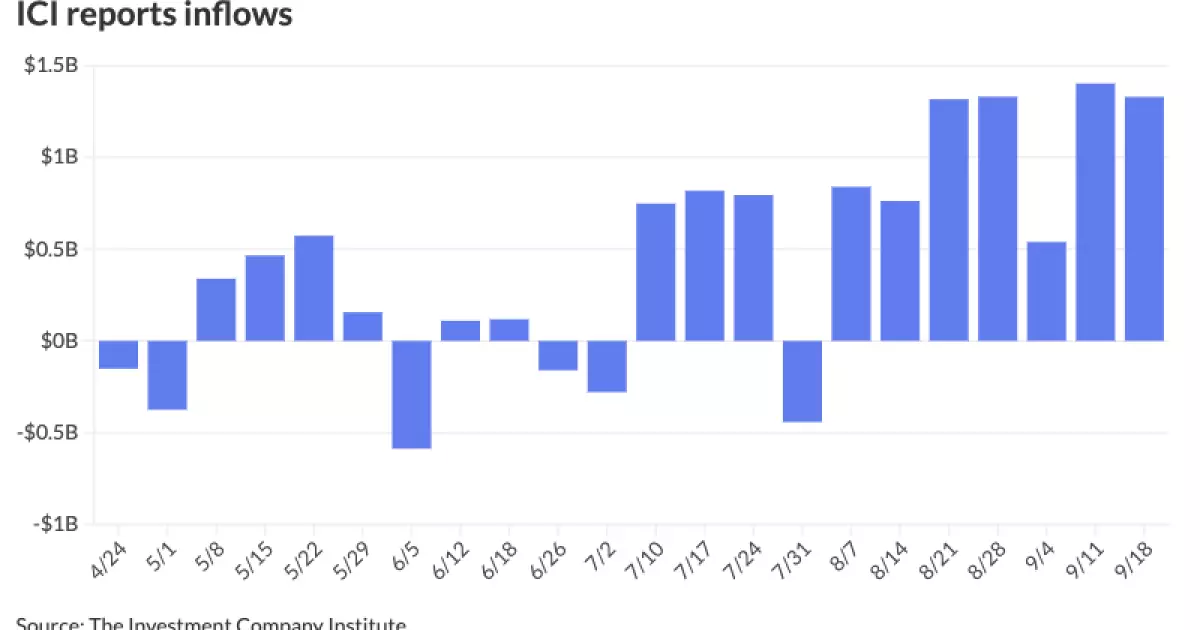The municipal bond market has exhibited a remarkable steadiness, drawing considerable attention as primary market activities have picked up with significant deals leading to lowered yields upon repricing. As equity markets faced losses and U.S. Treasuries displayed weakness, the municipal sector has emerged as a platform of relative stability amidst these fluctuations. This article delves into the recent activities in the municipal bond market, notable trends influencing dynamics, and implications for investors as we approach the year-end.
Recent reports from the Investment Company Institute reflect a sustained influx of capital into municipal bond mutual funds, with $1.329 billion recorded for the week ending September 18, following a remarkable $1.402 billion the week before. Additionally, exchange-traded funds witnessed $55 million in inflows, albeit a decrease from the previous week’s $1.048 billion. Strategists at Appleton Partners highlighted a pivotal transitional phase as summer yields to fall, suggesting that the robust reinvestment capital typical of summer might soon decline. They expressed concerns regarding the potential market volatility that could arise as reinvestment activity decreases towards year-end. The volatility is expected to align unpredictably with seasonal issuance spikes, which could add another layer of complexity to an already jittery market.
Issuance in the municipal bond market has remained robust, with nearly $14 billion in supply noted for the week. This solidity in issuance has been partly driven by a sense of urgency among issuers. According to Jon Mondillo, global head of Fixed Income at abrdn, concerns about possible market volatility following the upcoming presidential election have prompted issuers to expedite their offerings ahead of November 5. This scenario creates a landscape rife with fiscal uncertainty, which issuers seem eager to navigate through preemptive capital raising. The urgency is further illustrated by year-to-date issuance climbing to $357.913 billion, reflecting a substantial increase of 37.7% compared to last year’s figures.
Market dynamics indicate that the interplay of increased issuance and diminished reinvestment demand could subsequently elevate yields on municipal bonds. This potential yield enhancement might present a unique opportunity for investors looking to capitalize on municipal bonds at relatively favorable conditions. Presently, the 10-year municipal-to-U.S. Treasury ratio stabilizes around 70%. Appleton strategists note that an increase in supply combined with a limit on reinvestment demand could lead to higher ratios, further enhancing the attractiveness of municipal investment.
On the short end, the two-year municipal to Treasury ratios are recorded at 65%, while the long-end ratios, especially around the 30-year mark, exhibit a notable richness at about 85%-86%. This scenario creates a striking contrast to previous years when long-end ratios often surpassed 100%. Analysts suggest that for ratios to revert to historical values, Treasury yields would need to experience a significant downturn.
In recent primary market activity, BofA Securities led the way by pricing $1.061 billion of consolidated bonds from the Port Authority of New York and New Jersey. These yields reflected some adjustments in response to retail pricing, with various maturities encountering repricings that generally include small downward adjustments. For instance, yields on certain bonds were reduced by as much as seven basis points.
Similarly, significant deals, such as the $700 million Salt River Project electric system revenue bonds, showcased minor upward adjustments in yields that resonate with investor sentiment and market expectations. Wells Fargo and Baird also participated, pricing a series of school district and educational facility bonds respectively, each with a varied yield structure to pique investor interest.
As we approach a potentially transformative period in the municipal bond landscape, investors should stay attuned to fluctuating market conditions and strategic issuances that aim to navigate emerging volatility. The anticipation surrounding upcoming fiscal decisions linked to the election could add yet another element to the evolving dynamic of the municipal bond market. Careful attention to yield trends, inflow patterns, and overall market sentiment will be essential for investors seeking to optimize their portfolios in this transitional phase.
Overall, the municipal bond market has retained its steadfastness during a period marked by broader economic fluctuation, indicating a unique opportunity for astute investors looking to leverage the current conditions. With upcoming events poised to influence the market significantly, stakeholders should remain vigilant and proactive as they navigate these uncharted waters heading into the final quarter of the year.

